Tardigrades – indestructible animals
Tardigrades – invincible animals
These “bears” invisible to the naked eye are one of the most extraordinary animals on Earth. Their survival skills and appearance amaze and also make you wonder. Probably, because of these two features, they are seen as extraterrestrial creatures… Let’s take a look at the cosmic tardigrades.
Classification
- Kingdom: Animalia
- Superphylum: Ecdysozoa
- Phylum: Tardigrades
- Classes:
- Heterotardigrada
- Eutardigrada
- Mesotardigrada
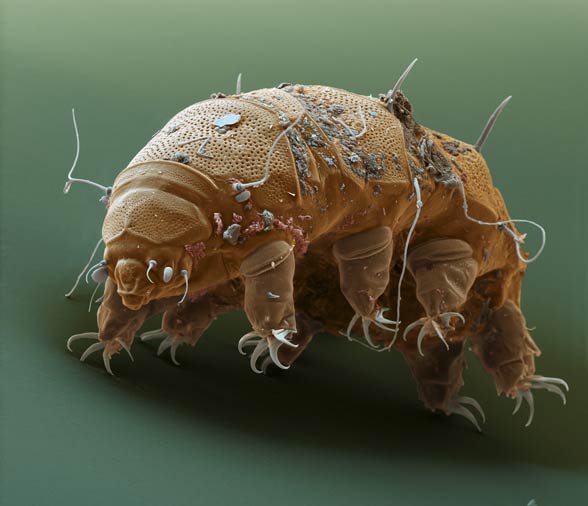
Evolution
The first fossils resembling tardigrades were found in Siberia. This finding dates back to the Cambrian period (about 540-485 million years ago).
On the basis of genetic studies, two theories have emerged. The first one says that tardigrades are the closest relatives of arthropods and Onychophora, and the second one says that they are closer to the nematodes. However, the latter one has been rejected after conducting additional DNA analyses.
The latest conclusions have shown that tardigrades are the sister group of Lobopodia, which includes the abovementioned Onychophora.

Occurrence – from one extremity to another
Tardigrades are cosmopolitan animals – they can be found in every region of the world, unless we don’t have a microscope :). Some species inhabit terrestrial, damp mosses, lichens, forest litter and soil, and some prefer freshwater or marine environment. In the course of evolution, plenty of species of tardigrades have developed, and each of them is adapted to a different habitat.
These animals that are invisible to the naked eye can survive in various conditions. They have been found in hot springs and on top of the Himalayas, under thick layers of ice, and in ocean sediments. Many of species chose ponds, lakes, or meadows for their habitats, and other live in stone walls.
The common denominator of all tardigrades is moisture, although, they can do without it even for… 100 years! Besides, it’s not their only skill that is amazing.
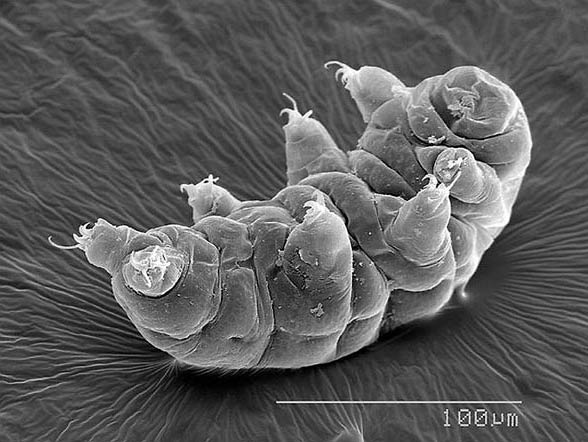
Anatomy
Size
The elongated body is supported by 3-4 pairs of thick legs. Usually, the body length is between 0.3 and 0.5 mm (0.011-0.019 in), but some species can be about 1.2 mm (0.047 in) long.
Appearance
The body is clearly segmented into a head, trunk, and abdomen. The middle part, consisting of three segments, is equipped with legs without joints, but the microscopic feet have 4-8 claws. The cuticle consists of chitin and protein.
Tardigrades, similarly to crustaceans and insects, which they are the most closely related to, moult regularly.
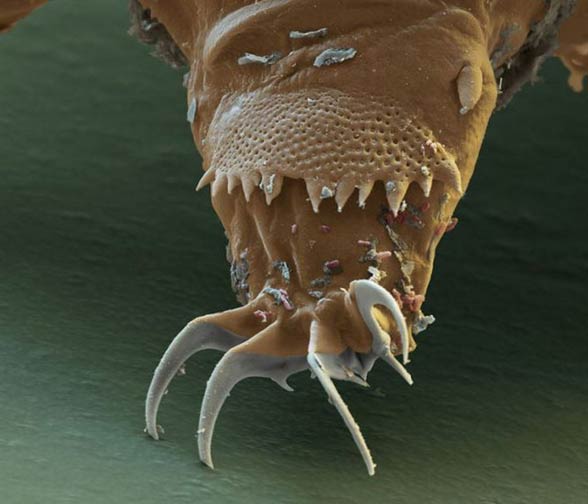
Circulatory system
The body cavities consist of the circulatory system, but the only place where it can be found is around the gonad.
They don’t breathe…
Tardigrades have no airways, so there is no gas exchange. Some species possess tubular glands placed around the rectum, that may serve as excretory organs. They resemble the Malphigian tubules, characteristic for arthropods. However, the role of this organ in tardigrades has not been fully known.
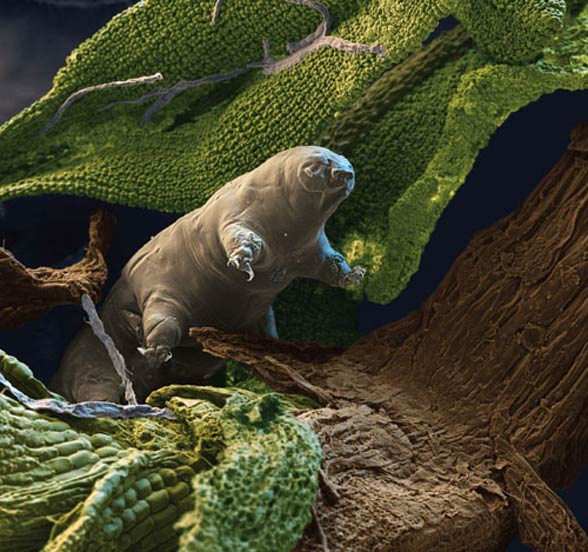
Food and defecation
The tubular mouth on the head has teeth-like structures, thanks to which the animal pierces the plant cells, algae, or small invertebrates, to suck out their contents. The food goes from the mouth through the pharynx to a short esophagus which is connected to the intestines that constitute the most of the body length. Redundant metabolic products are excreted on an ongoing basis, or only during moulting (feces are detached from the body with the dead cuticle). The way of defecation is closely related to the species.
Brain
The brain consists of several groups of neurons. This organ is connected with a large ganglion, which is located below the esophagus. A double ventral nerve cord runs the length of the body from there. It is responsible for leg movements, that are connected with it with special nerve fibers.
Sight
Many species possess a pair of ommatidia – conical organs (elements of the compound eyes) responsible for vision. Apart from the eyes, tardigrades have sensory bristles that cover the head and trunk.
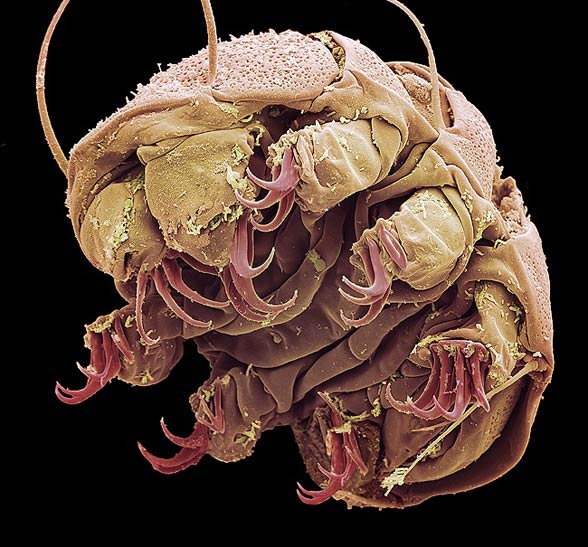
Reproduction
Many tardigrades reproduce by parthenogenesis (the development of the young from an egg cell without a spermatozoon), but gonochorism also occurs. Females have a cloaca, and males two separate openings in the back of the body.
Tardigrades are egg-bearing, and fertilization is external. Mating occurs during moulting, when the female shows egg cells along with the redundant cuticle layer. After moulting, the male covers the egg cells with sperm.
However, external fertilization does not always occur, because there are species that have internal fertilization, and it also occurs when the female moults. After about 14 days after fertilization, the eggs hatch.
As tardigrades are eutelic (they have the same number of body cells since birth), their growth is based not on cell multiplication, but on the enlargement of particular, already existing cells.
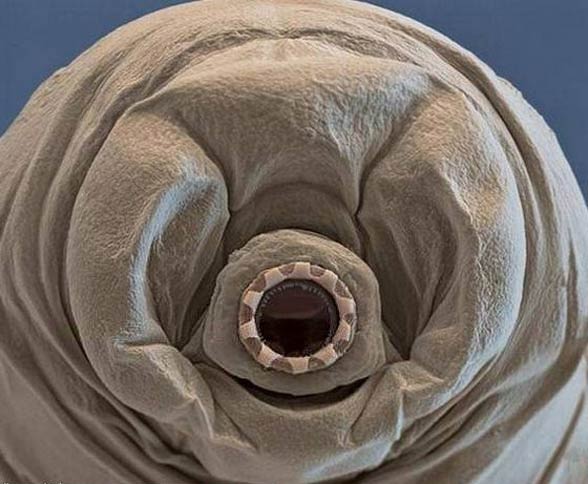
Survival skills
Tardigrades can survive in conditions that would kill every other organism. Although it sounds incredible, these animals endure extremes that are lethal for humans, including:
- Pressure – tardigrades can survive both in a vacuum and under pressure 1,200 times higher than atmospheric pressure. Some species endure pressure of 6,000 atmospheres (about 6 times higher than the highest pressure of the Mariana trench (10911 ±40 m (35797 ft ±131 ft) below sea level) – the deepest oceanic trench on Earth.
- Temperatures – these animals can endure several minutes in temperature of +151°C (304ºF) and about 24 hours in -200°C (-328ºF). Some species can withstand a couple of minutes in -272°C (the lowest temperature in nature is -273.15°C = 0°K (-460ºF)).
- Radiation – tardigrades endure 1000 times more radiation than other animals; the average lethal dose of 5,000 Gy (grays) and 6,200 Gy of heavy ions in hydrated animals, and only 5-10 Gy in humans.
- Dehydration – these animals can survive dehydrated even 10 years, although there was one individual found that lived as many as 120 years (it lived on dried moss). In very low temperatures, water constitutes only 3% of the tardigrade’s body. In normal conditions, it is as many as 85%. When water freezes, it expands. Thus, by removing it from their organisms, tardigrades avoid being ripped apart by the ice.
- Toxins – tardigrades respond to high levels of toxins in the environment with an extreme decrease in metabolism and they fall into a state similar to hibernation, called cryptobiosis or suspended animation (houseflies also can do that). When the environment cleanses, the animal returns to its normal state.
- Outer space – tardigrades are the only known animals that can survive in outer space. It was proved in 2007 when several dehydrated individuals were sent into low Earth orbit. For 10 days, the tardigrades were exposed to the hard vacuum and UV radiation. When they returned to Earth, about 68% individuals were “brought back to life” by rehydration. In 2011 Italian scientists sent another group of tardigrades into space. On the basis of observations and tests it was shown that radiation and lack of gravitation didn’t affect significantly the animals’ survival, therefore, they were considered to be very useful in studies conducted in outer space.

Detailed information and measurements
Tardigrades (Tardigrada)
- Body length: 0.05-0.5 mm (0.002-0.019 in), max. 1,2-1,5 mm (0.047-0.059 in)
- Lifespan: 10-100 years

Tardigrades (Tardigrada) – interesting facts
- The name tardigrade means “slow stepper”. It was coined in 1776 by Lazazaro Spallanzani. These animals are also known as water bears, because of the way they move.
- There have been about 1,150 species of tardigrades classified so far.
- The tardigrade can moult up to 12 times in its lifetime.
- An alternative theory says that tardigrades come from another planet, and they came to Earth travelling on asteroids that used to hit our planet.
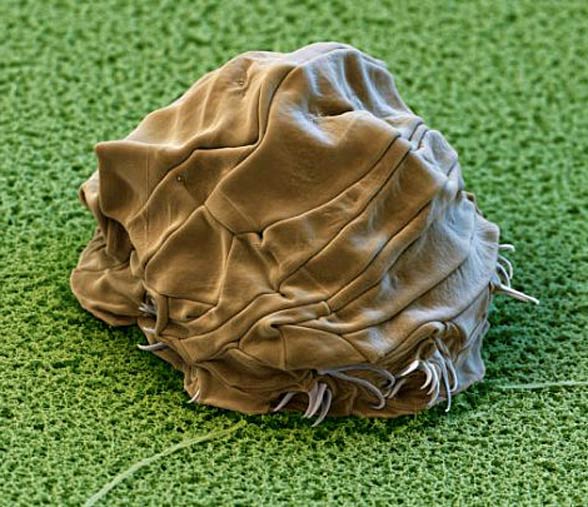
Recommended
- Largest eagles Top10
- Largest birds of prey Top10
- Animals & dinosaurs records
- The fastest animals – Top 100
- The fastest birds – Top 10

















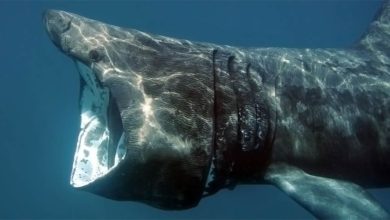


Geweldig artikel, leest heerlijk weg.
De laatste foto deed mij lachen! Dit maakte mijn dag. Dank je